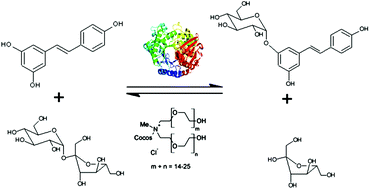Ionic liquids as cosolvents for glycosylation by sucrose phosphorylase: balancing acceptor solubility and enzyme stability†
Abstract
Over the past decade,

* Corresponding authors
a
Centre for Industrial Biotechnology and Biocatalysis, Department of Biochemical and Microbial Technology, Faculty of Biosciences Engineering, Ghent University, Coupure Links 653, B-9000 Ghent, Belgium
E-mail:
tom.desmet@ugent.be, karel.dewinter@ugent.be
Fax: +32 92646032, +32 92646032
Tel: +32 92649920, +32 92649921
b Laboratory of Biotransformation, Institute of Microbiology, Academy of Sciences of the Czech Republic, Vídeňská 1083, 142 20 Prague, Czech Republic
Over the past decade,

 Please wait while we load your content...
Something went wrong. Try again?
Please wait while we load your content...
Something went wrong. Try again?
K. De Winter, K. Verlinden, V. Křen, L. Weignerová, W. Soetaert and T. Desmet, Green Chem., 2013, 15, 1949 DOI: 10.1039/C3GC40449H
To request permission to reproduce material from this article, please go to the Copyright Clearance Center request page.
If you are an author contributing to an RSC publication, you do not need to request permission provided correct acknowledgement is given.
If you are the author of this article, you do not need to request permission to reproduce figures and diagrams provided correct acknowledgement is given. If you want to reproduce the whole article in a third-party publication (excluding your thesis/dissertation for which permission is not required) please go to the Copyright Clearance Center request page.
Read more about how to correctly acknowledge RSC content.
 Fetching data from CrossRef.
Fetching data from CrossRef.
This may take some time to load.
Loading related content
